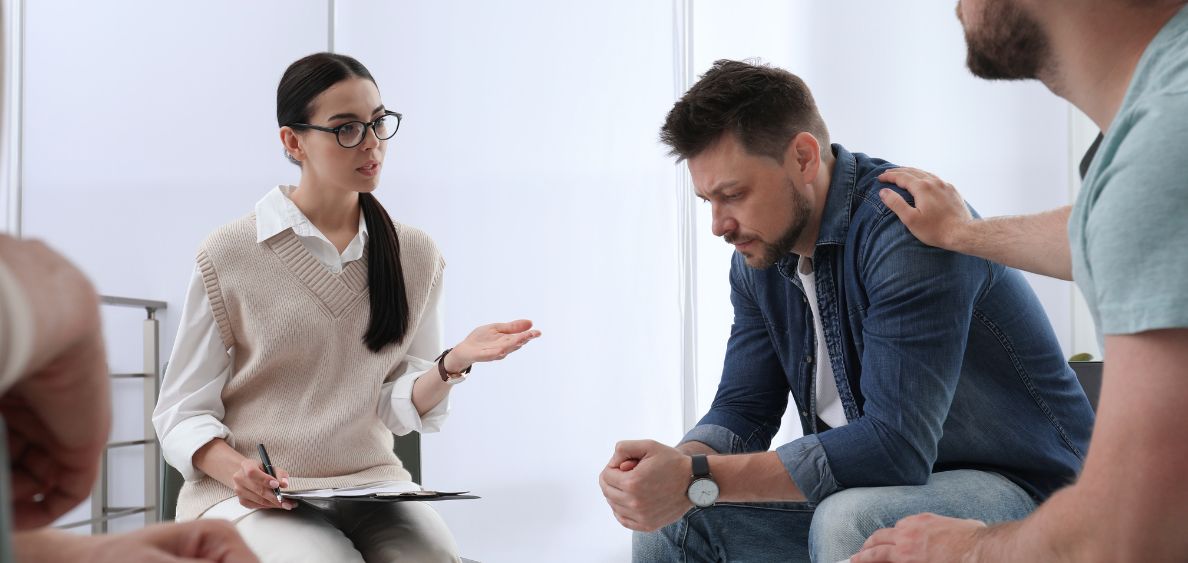
Written by:
Last Updated:
October 29th, 2025
As you watch a loved one struggling with drug addiction, you may sadly see control slipping away from them. Your pleas and heartfelt attempts to help them stop are brushed aside, as addiction forces them to return to the substance, with no end in sight.
At this time, interventions may become the key that opens the door that addiction keeps locked.
This guide helps you recognise if and when an intervention is needed, and provides clear steps to plan one. Your timely support may just save your loved one’s life.

What is a drug intervention?
An intervention is a planned process in which an addicted person’s loved ones come together and create an action plan to help that person begin the recovery process. Interventions are usually shaped and designed by a support group, without the addicted person’s foreknowledge. They can be carried out by the group alone or with the help of a doctor, healthcare worker, or addiction expert.
The origin of the word intervention is from the Latin term intervenire, meaning to come between, to interrupt, or to confront a problem. The word ‘intervention’ is often thought of as quite severe, carrying weight when it lands on our ears. They are not always an act of sheer desperation, but generally, they are used when the pleas of loved ones are ignored and a person must receive outside help. They come from a place of love, but are often met with a degree of disagreement or even hostility from the addicted person.
The best interventions finish with actionable steps, so that the addicted person does not feel like they have only been lectured to. Presenting these steps to your loved one can be integral in helping them make the first move. An intervention can be very emotionally charged, so the best way to plan one is to remember kindness, compassion and empathy, not just for the addicted person, but for all involved.
How can I be sure a drug intervention is needed?
The signs and indicators that an intervention is needed are not always easy to see. You may feel your concern tip into crisis, but feel unsure as to whether you have proof that one is needed. One of the cornerstones of intervention plans is a group consensus. You generally won’t carry out an intervention alone, and there will be multiple sources of input to consider. It’s crucial you keep a level head and think each sign through:
What are the steps to planning an intervention?
If you’ve been through the above signs and decided that an intervention is needed, it will benefit you to create a plan beforehand. Interventions will always be highly unique to the dynamic of the group that makes it, but there are general steps to follow for a stronger intervention:
- Create the right intervention group: Have a think about the group that will express their concerns to the addicted person. It should generally consist of people who are immediately affected by the addiction, and can include family, loved ones and close friends. Each person needs to give input during the intervention about the way they feel.
- As a group, decide if outside help is needed: Once your circle of loved ones is set up, think carefully about whether outside help from a professional interventionist is needed. These people may provide clear neutrality in the intervention, which will be beneficial when emotions are running high.
- Choose the right setting: Now you should decide exactly where the intervention should take place. Put careful thought into choosing a location that is calm and where every voice can be heard. Home settings are often not the best choice, as the person may want to retreat into their personal space, like a bedroom, and feel encroached upon if you continue.
- Carry out the intervention with care: Now’s the time to carry out the intervention. You ask your loved one to join the intervention site, and each person is given ample time to express their feelings, without being interrupted. While empathy and care are essential, it’s also important to make sure nobody is afraid to say how they feel. Avoid escalating the situation if arguments arise. This should be the place where loved ones can open up about the pain that an addiction has inflicted on them.
- Finish with clear boundaries and your “next step”: Here, you need to think about the future. You decided an intervention is needed, so it helps if you have contact details ready for your loved one to use.
Where can I find help for an addiction in my life?
If you’re considering a drug intervention, it often means the situation has already reached a critical point. Please remember, you don’t have to face this alone. Professional support can guide you through the process and provide the right treatment options for lasting recovery.
At Sanctuary Lodge, we help families and individuals every day to take that first courageous step. Our recovery programmes deliver medical detox and continue with evidence-based therapy. If you’re ready to act, reach out to us today. One call with our admissions team could be the beginning of a new chapter for you or your loved one.




